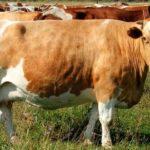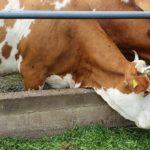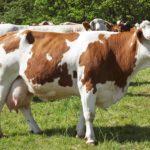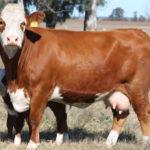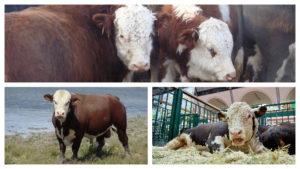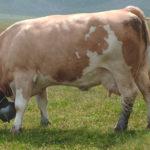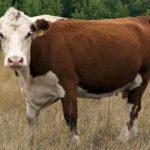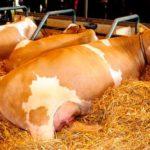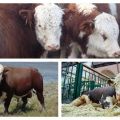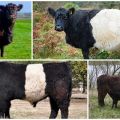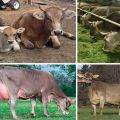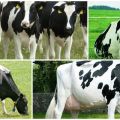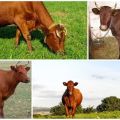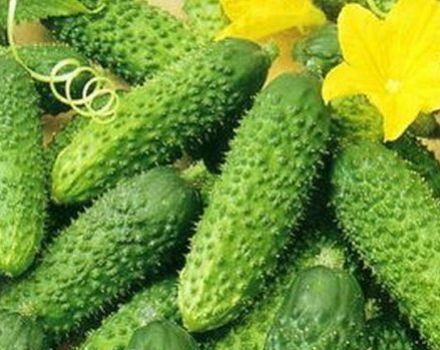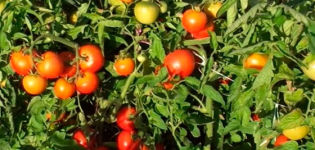Description and characteristics of Simmental cattle and cow maintenance
The Simmental breed of bulls and cows has a characteristic meaty exterior - a long rectangular body, a muscular dense body. However, these animals originally from Switzerland are bred not only for meat. Over the course of 15 years, cows constantly produce from 3.5 to 7 thousand kg of milk per lactation period. For the sake of meat, gobies are bred, and they are kept in a stall so that they feed faster and move less.
Origin story
Simmental cows are animals bred in Switzerland in the region of the Simma River (Bernese Highlands). They are of the meat and dairy type. Characteristic features: fawn (light brown) color with white spots, huge long rectangular body, muscular body, short legs, highly attached udder.
There are Simmental cows with horns and hornless ones. These are record-breaking animals among cattle in terms of slaughter meat yield and milk yield. The Simmental breed was bred by folk selection. The ancestors of these animals are considered to be cattle from Scandinavia. In the 5th century, work began to improve the breed. In the middle of the 19th century, seed-breeding cows and simmental bulls became the most popular animals in Europe, as their breeding was profitable in terms of milk and meat.
This breed was loved for its calm nature, high productivity and unpretentious care. In Russia and Ukraine, the Simmental cow appeared only at the end of the 19th century.
On the basis of Simmentals, new breeds were developed in breeding farms (Montbeliard, Hungarian, Bulgarian, Slovak variegated, Fleckfi). Breeding more productive species of Simmental cows have been engaged in by zootechnicians in Germany for over 100 years. These animals are adored by farmers in Bavaria, Baden-Württemberg and Hesse. Purebred heifers from Germany cost almost $ 2,000. Before the first calving, cows gain about 600 kg of weight.
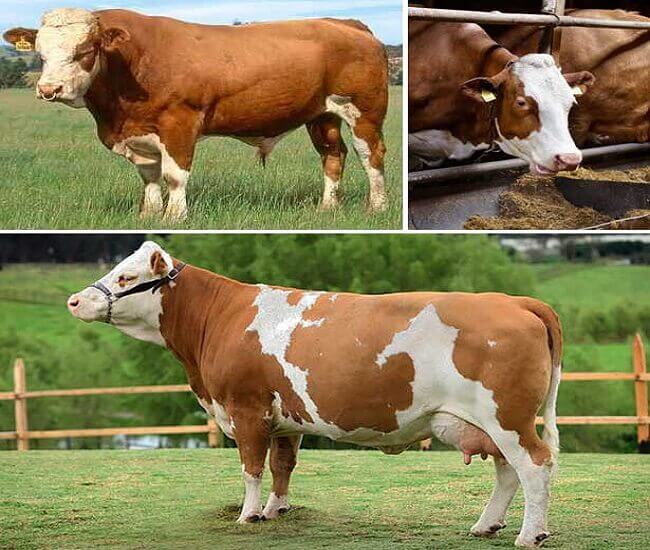
Description and characteristics of the Simmental breed
The appearance and main features of the Simmental:
- color - fawn, variegated (fawn-white);
- body length - 161-165 cm;
- height at the withers - 134-141 cm;
- cow weight - 555-650 kg;
- weight of bulls - 905-1200 kg;
- the weight of newborn calves is 35-45 kg;
- there are breeds with horns and hornless ones;
- the body is wide, rectangular, long;
- the head is large with a wide forehead;
- the neck is short;
- back straight;
- the skin is thick and strong;
- legs are short;
- the body is muscular;
- the udder is rounded, raised, the nipples are cylindrical;
- the chest is deep and large, the loin is wide;
- the nose and eyelids are pink (no blemishes).
In Simmental cows, the color is sometimes reddish (red) or red-white. Animals are characterized by large muscular bodies, high productivity and rapid weight gain. A cow gives about 15-18 liters of milk per day. The female gives birth to 1-2 calves annually.
Simmental young bulls are highly prized. They are bought for fattening meat. In the first months of life, Simmental (simmental) calves grow rapidly, gaining almost 1000-1300 grams in weight every day. This feature of their body allows you to save feed and quickly get meat products. At 18 months, gobies already weigh 600 kg. Slaughter meat yield is almost 65 percent.
Main pros and cons
Content rules
Simmental cows can adapt to any climate. The main thing is to keep the cattle clean, on dry bedding and provide quality feed. Simmentals do not conflict with other animals, but they need their place in the barn.
Cows are kept in a room where the temperature is maintained at 15-20 degrees Celsius all year round, ventilation is provided, there is a manger for hay, a feeder and a drinking bowl.
In the warm season, Simmentals are recommended to graze in the meadow. In snow and frost, it is better to keep animals indoors, but be sure to walk them daily on a walking area or near a barn. The cows are fed 2-3 times a day, milked three times a day.
Required care
Simmental cows are very clean animals. They need to change the bedding daily. If a cow sleeps on dirty and wet straw, it can develop udder mastitis. Cattle should be kept in a clean, dry, well-ventilated room without drafts. It is advisable to equip a walking area near the barn so that the cows go out for a walk at any time of the year. The walking area can be protected from precipitation by a canopy.

Animals must be provided with food and water. Cows should eat and drink to their fill. In addition, milk yield directly depends on the amount of water. Before each milking, the udder of a Simmental cow should be washed with warm water and dried with a clean towel. It is advisable to lubricate the nipples with fat. The hind legs must be constantly cleaned of feces and dirt. It is recommended to give drugs for intestinal parasites and lice every six months.
Diet
It is recommended to graze the cows in the pasture throughout the warm period. It is advisable to keep cattle in the stall only in winter. One cow eats up to 50 kg of grass per day and drinks almost 30 liters of water. For the winter, the animal needs to prepare 0.5 tons of hay. Cows are driven to pasture in early spring, when the grass reaches 15 cm in height. The preferred vegetation is leguminous and cereal.
The main food for these ruminants is fresh grass in summer and hay in winter. As a top dressing, the Simmental are allowed to give finely chopped vegetables, fruits, grain mixtures, and compound feed. In winter, animals can be fed with silage, straw.In winter, it is recommended to give the Simmentals pharmaceutical vitamin and mineral preparations and sweet water. A Simmental cow should eat 20-50 grams of salt daily.
Breeding
Sexual maturity in the Simmental breed occurs at 20 months. True, females mate a little later. Usually, Simmental cows are inseminated (naturally or artificially) at 24-25 months, that is, at the age of two years. Pregnancy lasts 9 months. The pregnant cow is transferred to dead wood and gradually start to run. 2 months before the birth of the calves, the female stops milking.
The Simmentals give birth easily, the female gives birth on her own. Healthy calves weighing 35-45 kilograms are born. Newborns can be cut off the umbilical cord and treated with iodine, cleaned of mucus from the nostrils.
After birth, the afterbirth leaves the uterus. It is advisable to remove the place from the barn so that the cow does not eat it, otherwise digestive problems are possible.
Newborns can be fed colostrum for 30 minutes after birth. Little calves are eaten 5 times a day. Over time, the number of feedings is reduced (brought to three times a day). Colostrum is removed after each meal so that the cow is milked faster and more milk flows into the udder.
At the age of one month, calves should already drink liquid from a bucket. Milk can be diluted a little with water. In the first 4 months of life, the calves are kept with the mother. Cubs are fed with mother's milk, gradually accustoming to grass. At this age, calves grow rapidly, gaining almost 1 kilogram daily. The cow recovers well after giving birth, during this period she is given juicy feed. It is desirable that the next calving takes place after 380 days.

Diseases and their treatment
The Simmental cattle breed has good immunity. True, with improper and poor-quality nutrition and errors in care, animals get sick. Diseases are mainly caused by humans (if cows are poorly looked after, vaccinations are not given on time).
Common diseases and treatments:
- tympania (bloating, flatulence) - occurs when using legumes and a large amount of water, is treated by protruding the tongue outward, inserting a probe into the esophagus, infusing fresh milk, vodka solution, tincture of dill, the drug "Tympanol";
- mastitis (udder disease) - occurs when the rules for keeping and milking cows are violated, udder tissue injuries, is treated by transferring from succulent feed to hay, limiting watering, frequent milking and emptying the udder from the contents, to facilitate milking, prescribe "Oxytocin", "Pituitrin", 1-2% sodium bicarbonate solution, antibiotics are injected with inflammation;
- hoof diseases - occur as a result of keeping on wet and dirty litter, large weight of cattle, are treated by cleansing the hooves with an antiseptic (hydrogen peroxide, "Chlorhexidine"), wound healing ointments and antibiotics (streptocidal ointment, "Levomekol", tetracycline) and applying cotton gauze bandages.
It is recommended to vaccinate young calves immediately after birth. Ask your local veterinarian for a vaccination plan. Usually, at the age of 1 to 3 months, calves are vaccinated against viral pneumonia, anthrax, foot and mouth disease, rabies.
What to look for when buying
It is better to buy Simmental cows on your own, that is, examining each individual before buying. The desired age is 2-3 years. It is not recommended to buy old Simmental cows (over 6 years old). When buying, it is recommended to look at the appearance and make sure the health of the animal.
What they pay attention to when buying Simmentals:
- on color - piebald with white spots on the head, belly, legs;
- the nose and eyelids should be pink (no dark or light spots);
- there should be no discharge near the eyes and nostrils;
- there should be 32 teeth in the mouth (cows have no upper incisors);
- legs - parallel to each other, not too wide or close apart;
- wool - dense, clean, without lichen spots, shiny;
- the eyes are clean, the sclera are white, the pupils are not cloudy;
- udder - cup-shaped, loose, symmetrical, without seals, with visible veins;
- temperature - 38.3 degrees;
- pulse - 57-67 beats per minute;
- respiratory rate - 20 breaths per minute.
Where and at what price to buy simmentals
Simmental cows can be bought from local breeding farms or abroad. Young purebred Simmentals - calves, heifers and bulls - are brought from Germany, Austria and Switzerland. The cost of the animal plus transportation will cost 2-3 thousand dollars.
You can buy a thoroughbred cow from local breeders for $ 800-1000. You can find out who sells simmental in a particular area using the Internet.


